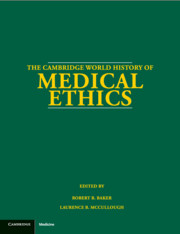Book contents
- Frontmatter
- PART I AN INTRODUCTION TO THE HISTORY OF MEDICAL ETHICS
- PART II A CHRONOLOGY OF MEDICAL ETHICS
- PART III DISCOURSES OF MEDICAL ETHICS THROUGH THE LIFE CYCLE
- PART IV THE DISCOURSES OF RELIGION ON MEDICAL ETHICS
- PART V THE DISCOURSES OF PHILOSOPHY ON MEDICAL ETHICS
- PART VI THE DISCOURSES OF PRACTITIONERS ON MEDICAL ETHICS
- PART VII THE DISCOURSES OF BIOETHICS
- PART VIII DISCOURSES ON MEDICAL ETHICS AND SOCIETY
- Ethical and Legal Regulation of Medical Practice and Research
- B Medical Ethics, Imperialism, and the Nation-State
- 52 Colonialism, Imperialism, and the History of Latin American Medical Ethics
- 53 Japanese Doctors’ Experimentation, 1932–1945, and Medical Ethics
- 54 Medical Ethics and Nazism
- 55 Medical Ethics and Communism in the Soviet Union
- 56 Medical Ethics and Communism in Eastern Europe
- 57 The Ethics of Military Medical Research in the United States during the Cold War
- 58 Medical Ethics and the Military in South Africa during Apartheid: Judging History
- C Medical Ethics and Health Policy
- Appendix: Biographies: Who Was Who in the History of Medical Ethics
- Bibliography
- Index
55 - Medical Ethics and Communism in the Soviet Union
from B - Medical Ethics, Imperialism, and the Nation-State
Published online by Cambridge University Press: 28 May 2012
- Frontmatter
- PART I AN INTRODUCTION TO THE HISTORY OF MEDICAL ETHICS
- PART II A CHRONOLOGY OF MEDICAL ETHICS
- PART III DISCOURSES OF MEDICAL ETHICS THROUGH THE LIFE CYCLE
- PART IV THE DISCOURSES OF RELIGION ON MEDICAL ETHICS
- PART V THE DISCOURSES OF PHILOSOPHY ON MEDICAL ETHICS
- PART VI THE DISCOURSES OF PRACTITIONERS ON MEDICAL ETHICS
- PART VII THE DISCOURSES OF BIOETHICS
- PART VIII DISCOURSES ON MEDICAL ETHICS AND SOCIETY
- Ethical and Legal Regulation of Medical Practice and Research
- B Medical Ethics, Imperialism, and the Nation-State
- 52 Colonialism, Imperialism, and the History of Latin American Medical Ethics
- 53 Japanese Doctors’ Experimentation, 1932–1945, and Medical Ethics
- 54 Medical Ethics and Nazism
- 55 Medical Ethics and Communism in the Soviet Union
- 56 Medical Ethics and Communism in Eastern Europe
- 57 The Ethics of Military Medical Research in the United States during the Cold War
- 58 Medical Ethics and the Military in South Africa during Apartheid: Judging History
- C Medical Ethics and Health Policy
- Appendix: Biographies: Who Was Who in the History of Medical Ethics
- Bibliography
- Index
Summary
INTRODUCTION
The year 1917 was a turning point in Russian and World history. Two revolutions occurred within that year. In February 1917 Czar Nicolas Ⅱ abdicated the throne and Russia was proclaimed a republic. On October 25, 1917 (November 7th on the Gregorian calendar) power was seized by Bolsheviks, led by Lenin (Vladimir Ul’yanov) and Leo Trotsky (Leiba Bronshtein) under the slogans: “All power to the Soviets!” “Peace to the peoples!” “Land to the peasants!” and “Factories to the workers!”
Despite hunger, Civil War, and economic collapse, truly revolutionary changes were made in all spheres of life. The Narodny commissariat zdravookhranenija,RSFSR (Ministry of Health of Russian Soviet Federal Socialist Republics) was established in 1918. An editorial in The Journal of the American Medical Association on Johannes Peter Frank (1745–1821) suggests that the best English translation of his term “medizinischen Polizey” is “public health by decrees” (Editorial 1967). That was exactly the way the Bolsheviks introduced the new system of public health – by decrees. Headed by Lenin's ally Nikolai Semashko (1874–1949), the RSFSR issued decrees legalizing abortion (in 1920) and active euthanasia (physician-assisted suicide) (in 1922), becoming the first country in the world to legalize either.
For the 20-year period, from 1917 to 1937, the number of medical doctors increased fivefold. The Union of Soviet Socialist Republics (USSR) became the country with the second largest number of physicians in the world, second only to the United States. Many medical doctors were women.
- Type
- Chapter
- Information
- The Cambridge World History of Medical Ethics , pp. 609 - 616Publisher: Cambridge University PressPrint publication year: 2008
- 1
- Cited by



